Snowflake
News
... Some recent milestones and notable events from
the world of snowflakes ... |
|
|
Snowflake Photographs appear
on Swedish Postage Stamps |
 November
27,
2010 – The Swedish Postal Service issues a set of five postage
stamps featuring snowflake photographs taken by Kenneth Libbrecht.
The 12-kroner stamps are used for international first-class postage. The
snowflake photographs used to make the winter holiday stamps were taken
by Libbrecht in the town of Kiruna in northern Lapland. November
27,
2010 – The Swedish Postal Service issues a set of five postage
stamps featuring snowflake photographs taken by Kenneth Libbrecht.
The 12-kroner stamps are used for international first-class postage. The
snowflake photographs used to make the winter holiday stamps were taken
by Libbrecht in the town of Kiruna in northern Lapland.
|
|
Snowflake Photography
Recognized with 2010 Lennart Nilsson Award |
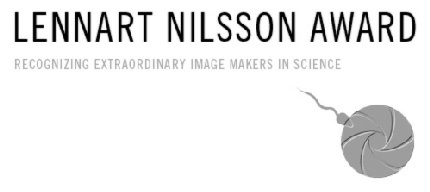 November
20,
2010 – Kenneth Libbrecht receives the 2010 Lennart Nilsson Award.
Including a cash prize of 100,000 kronor, the award "is the world's most
prestigious distinction in scientific and medical photography" and is
presented each year in Stockholm in honor of Lennart Nilsson, the
legendary Swedish photographer. According to the board's citation,
"Kenneth Libbrecht's images open our eyes to the regularity and beauty
of nature. With his photographs of snowflakes, he turns mathematics,
physics, and chemistry into images of great beauty." November
20,
2010 – Kenneth Libbrecht receives the 2010 Lennart Nilsson Award.
Including a cash prize of 100,000 kronor, the award "is the world's most
prestigious distinction in scientific and medical photography" and is
presented each year in Stockholm in honor of Lennart Nilsson, the
legendary Swedish photographer. According to the board's citation,
"Kenneth Libbrecht's images open our eyes to the regularity and beauty
of nature. With his photographs of snowflakes, he turns mathematics,
physics, and chemistry into images of great beauty."
For more information, see
The Lennart
Nilsson Award |
|
Children's book describes
the science and art of snowflakes |
 January,
2010 – The Secret Life of a Snowflake takes a close look at snowflakes.
Aimed at a juvenile audience, this book explains where snowflakes come
from, why they are symmetrical with six sides, and other basic aspects
of snow, weather and snowflakes. January,
2010 – The Secret Life of a Snowflake takes a close look at snowflakes.
Aimed at a juvenile audience, this book explains where snowflakes come
from, why they are symmetrical with six sides, and other basic aspects
of snow, weather and snowflakes.
For more information, see
Snowflake Books. |
|
Snowflake Photography
Recognized with Emile Chamot Award |
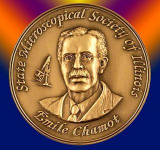 July
5,
2009 – Kenneth Libbrecht selected for 2009 Emile Chamot Award. The
award is given each year by the State Microscopical Society of Illinois
"for outstanding contributions to the field of light microscopy and
photomicroscopy." July
5,
2009 – Kenneth Libbrecht selected for 2009 Emile Chamot Award. The
award is given each year by the State Microscopical Society of Illinois
"for outstanding contributions to the field of light microscopy and
photomicroscopy." |
|
CBS News Sunday Morning Report |
 March
1, 2009 – CBS News Sunday Morning airs a 6-minute piece featuring KGL's
snowflake science. CBS local news in Los Angeles aired an
accompanying story the following day. Click
here to view. March
1, 2009 – CBS News Sunday Morning airs a 6-minute piece featuring KGL's
snowflake science. CBS local news in Los Angeles aired an
accompanying story the following day. Click
here to view. |
|
First accurate computer
modeling of snowflakes |
 March,
2008 – Researchers use the mathematics of cellular automata to produce
the world’s first realistic computer-generated snowflakes.
David Griffeath (Univ. Wisconsin) and Janko Gravner (UC Davis) solved
the equations governing faceted crystal growth using cellular automata
to produce numerical models of snowflakes that look just like the real
thing. Previous models of dendritic growth could not reproduce the
development of strongly faceted crystals like snowflakes. This
breakthrough in numerical modeling gives researchers an important new
tool for studying the detailed molecular dynamics of crystal growth. March,
2008 – Researchers use the mathematics of cellular automata to produce
the world’s first realistic computer-generated snowflakes.
David Griffeath (Univ. Wisconsin) and Janko Gravner (UC Davis) solved
the equations governing faceted crystal growth using cellular automata
to produce numerical models of snowflakes that look just like the real
thing. Previous models of dendritic growth could not reproduce the
development of strongly faceted crystals like snowflakes. This
breakthrough in numerical modeling gives researchers an important new
tool for studying the detailed molecular dynamics of crystal growth.
For more on computer-generated
snowflakes using cellular automata, see David Griffeath's web page
here.
|
|
Large-format book of
snowflake photographs |
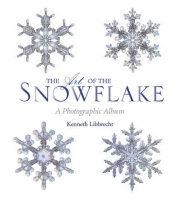 October,
2007 – The Art of the Snowflake provides remarkable new views of
the microscopic beauty of snowflakes. The book, published by
Voyageur Press and featuring snowflake photography by Kenneth Libbrecht,
is the first substantial compilation of snowflake photographs in over
half a century, since Ukihiro Nakaya’s Snow Crystals in 1950 and
Wilson Bentley’s Snow Crystals in 1931. The book presents
numerous large-format, high-resolution, color photographs that reveal
snow crystal structure in unprecedented detail. October,
2007 – The Art of the Snowflake provides remarkable new views of
the microscopic beauty of snowflakes. The book, published by
Voyageur Press and featuring snowflake photography by Kenneth Libbrecht,
is the first substantial compilation of snowflake photographs in over
half a century, since Ukihiro Nakaya’s Snow Crystals in 1950 and
Wilson Bentley’s Snow Crystals in 1931. The book presents
numerous large-format, high-resolution, color photographs that reveal
snow crystal structure in unprecedented detail.
For more information, see
Snowflake Books. |
|
Snowflakes appear on The
Martha Stewart Show |
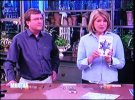 February
8, 2007 – Kenneth Libbrecht makes an appearance on The Martha Stewart
Show, talking about snowflakes, snowflake photography, and his
recent book, Ken Libbrecht’s Field Guide to Snowflakes.
Click
here to view. February
8, 2007 – Kenneth Libbrecht makes an appearance on The Martha Stewart
Show, talking about snowflakes, snowflake photography, and his
recent book, Ken Libbrecht’s Field Guide to Snowflakes.
Click
here to view. |
|
Snowflake stamps |
 October
5, 2006 – The United States Postal Service unveils a set
of four first-class postage stamps featuring snowflake photographs by
Kenneth Libbrecht. Over three billion stamps are printed and are
quickly sold out for holiday mailing. October
5, 2006 – The United States Postal Service unveils a set
of four first-class postage stamps featuring snowflake photographs by
Kenneth Libbrecht. Over three billion stamps are printed and are
quickly sold out for holiday mailing. |
|
First field guide to
snowflakes |
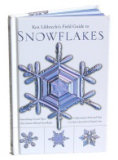 October,
2006 – Ken Libbrecht’s Field Guide to Snowflakes becomes the
world’s first field guide describing the many different types of snow
crystals. Readers are encouraged to venture outside with magnifiers
in hand to observe for themselves the many remarkable forms of falling
snow. October,
2006 – Ken Libbrecht’s Field Guide to Snowflakes becomes the
world’s first field guide describing the many different types of snow
crystals. Readers are encouraged to venture outside with magnifiers
in hand to observe for themselves the many remarkable forms of falling
snow.
For more information, see
Snowflake Books. |
|
Review article on snowflake
physics |
April, 2005 – The Physics of Snow Crystals is published in the
Reports on Progress in Physics*. The article by Kenneth
Libbrecht is the first comprehensive review of snowflake science in over
20 years.
*K. G. Libbrecht, Rep. Prog. Phys. 68
855-895 (2005).
View
pdf file (2.6 Mbytes)
|
|
CBS Evening News Report |
 January
10, 2004 – CBS Evening News airs a 2.5-minute piece featuring KGL's
snowflake science. Click
here to view. January
10, 2004 – CBS Evening News airs a 2.5-minute piece featuring KGL's
snowflake science. Click
here to view. |
|
First popular-science book
about snowflakes |
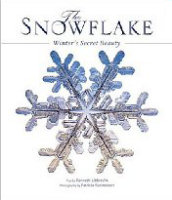 October,
2003 – The Snowflake: Winter’s Secret Beauty becomes the first
popular-science book about snowflakes. The book, written by
Kenneth Libbrecht with photographs by Patricia Rasmussen, tells the
story of snowflakes -- what they are, how they grow, and why they appear
in so many spectacular, symmetrical forms. It is the most
significant book on the subject since Ukihiro Nakaya’s Snow Crystals
(1950), which described his scientific investigations and photographs of
snowflakes, and Wilson Bentley’s Snow Crystals (1931), which
displayed many of his snowflake photographs. The Snowflake wins a
National Outdoor Book Award in 2004. October,
2003 – The Snowflake: Winter’s Secret Beauty becomes the first
popular-science book about snowflakes. The book, written by
Kenneth Libbrecht with photographs by Patricia Rasmussen, tells the
story of snowflakes -- what they are, how they grow, and why they appear
in so many spectacular, symmetrical forms. It is the most
significant book on the subject since Ukihiro Nakaya’s Snow Crystals
(1950), which described his scientific investigations and photographs of
snowflakes, and Wilson Bentley’s Snow Crystals (1931), which
displayed many of his snowflake photographs. The Snowflake wins a
National Outdoor Book Award in 2004.
For more information, see
Snowflake Books. |
|
Discovery of
electrochemically modified snowflake growth |
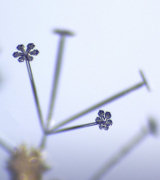 March,
2002 – Researchers discover a technique for growing slender ice needles
suitable for growing isolated artificial snowflakes.
Researchers at Caltech describe how to use electrically and chemically
modified crystal growth to produce ice needles oriented along the
crystalline c-axis. The fast-growing ice needles can be extremely thin,
with tips as small as 100 nanometers in diameter. The authors also
developed a theory that describes the needle growth under various
conditions. March,
2002 – Researchers discover a technique for growing slender ice needles
suitable for growing isolated artificial snowflakes.
Researchers at Caltech describe how to use electrically and chemically
modified crystal growth to produce ice needles oriented along the
crystalline c-axis. The fast-growing ice needles can be extremely thin,
with tips as small as 100 nanometers in diameter. The authors also
developed a theory that describes the needle growth under various
conditions.
For more information, see
Designer Snowflakes III and
Electric Growth. The research paper describing this work can be
downloaded
here*
(More research papers are available
here.)
*"Electrically Enhanced Free Dendrite
Growth in Polar and Non-polar Systems," K. G. Libbrecht, T. Crosby, and
M. Swanson, J. Cryst. Growth 240, 241 (2002).
|
|
New techniques in snowflake
photography |
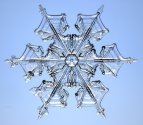 December,
2001 – Kenneth Libbrecht and Patricia Rasmussen extend the
state-of-the-art of snowflake photography by producing
super-high-resolution color images of snowflakes. The images
were acquired using a specially designed microscope with novel color
lighting techniques as well as advanced photomicroscopy hardware. December,
2001 – Kenneth Libbrecht and Patricia Rasmussen extend the
state-of-the-art of snowflake photography by producing
super-high-resolution color images of snowflakes. The images
were acquired using a specially designed microscope with novel color
lighting techniques as well as advanced photomicroscopy hardware.
For more about techniques, see
Photographing Snow. For more snowflake pictures, see my
Photo Galleries.
|
|
ABC World News Tonight
Report |
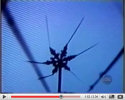 April
7, 2001 – ABC World News Tonight airs a 2.5-minute piece featuring KGL’s
snowflake science. Click
here to view. April
7, 2001 – ABC World News Tonight airs a 2.5-minute piece featuring KGL’s
snowflake science. Click
here to view. |
|
First snowflake website |
February, 1999 – The world’s first snowflake
website is launched. The site was created by Kenneth
Libbrecht and hosted by Caltech with the URL www.its.caltech.edu/~atomic/snowcrystals/
(later to become
SnowCrystals.com). The site is devoted to “snowflakes, snow
crystals, and other ice phenomena” and includes many high-resolution
color photographs. The website soon becomes a popular resource for
people interested in snowflakes.
|
|
New theory of electrically
modified snowflake growth |
July, 1998 – Kenneth Libbrecht and Victoria
Tanusheva describe a new theory for growing thin ice needles using high
voltages. The growth of “electric needles” of ice was first
discovered in 1963 by Basil Mason and collaborations in London, and the
phenomenon remained unexplained for 35 years. The new theory builds upon
solvability theory developed in the 1980s, adding the effects of
electrically enhanced diffusion on crystal growth.
For more information, see
Designer Snowflakes III and
Electric Growth. The research paper describing this work can be
downloaded here*
(More research papers are available
here.)
*Electrically Induced Morphological
Instabilities in Free Dendrite Growth," K. G. Libbrecht and V. M.
Tanusheva, Phys. Rev. Lett. 81, 176 (1998).
|
|
Movies show growth of
“designer” snowflakes |
August, 1997 – Kenneth Libbrecht and Victoria
Tanusheva produce the first movies of individual snowflakes growing on
the ends of thin ice needles. The ice needles were produced
using high electric fields following a technique discovered by Basil
Mason and collaborators in 1963. By changing the growth conditions with
time, Libbrecht and Tanusheva are able to control the shape of the
growing crystals, thus producing “designer” snowflakes.
For more information, see
Snowflake Movies. |
|
